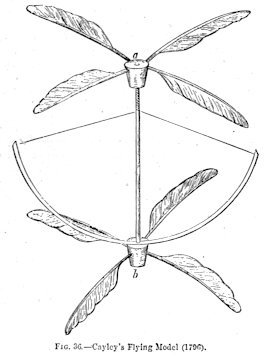Cayley's Flying Machine
Today, a boy begins what the Wrights will finish. The University of Houston's College of Engineering presents this series about the machines that make our civilization run, and the people whose ingenuity created them.
Sir George Cayley was born in 1773, in Yorkshire. He was studious from the start, and determined to solve the old riddle of human flight. He was 10 when the French invented hot air balloons, but they weren't good enough. Cayley knew that serious flying machines would eventually have to be heavier than air.
By his early twenties, he'd built a laboratory at his ancestral home of Brompton Hall. He was doing sophisticated aerodynamic studies. He also had the wits to hang out in a local watchmaker's shop -- studying mechanics at the same time he read Newton.
Cayley made several important discoveries. He realized the secret of flight wasn't to be learned from birds' flapping wings, but by watching birds glide with their wings fixed. He identified the three forces acting on the weight of any flying object -- lift, drag, and thrust. He conceived the idea of a lifting airfoil.
In a remarkable burst of insight, he saw that trout have the ideal, minimum-resistance, body shape for an airplane. Why a trout and not a bird? A century later we'd have rules of dynamic similitude. They show that a small fish in water behaves more like a large machine in the air than a small bird in the air does.
By 1799 he had the basic shape of a modern airplane with a fuselage, wing, and tail. By 1804 he was flying model gliders. In 1809 and 1810 he published a series of articles on his theories and experiments. He also showed how to scale up his models to make controllable human-bearing gliders.
Cayley scrupulously backed everything up with calculation. Newton had proposed a simple theory of lift which Cayley correctly took to task. Newton's theory makes sense only at speeds far greater than sound. It wasn't used for anything until after WW-II.
Cayley had brilliantly analyzed two of the three forces needed for aerial navigation -- lift and drag. The third force was thrust, and all we had were steam engines. They were still far too large and heavy. So Cayley put aside his studies and took up Whig politics. He became a member of Parliament.
But others read his principles and followed steam engine improvements. By mid-century the now-aging Cayley could no longer dodge his legacy. In 1853 he built a full-size glider and ordered his coachman, John Appleby, to test it. An eager crew towed it into the sky. Appleby glided safely down a hill.
Appleby felt plenty of fear and little sense of history. He immediately tendered his resignation. Cayley died soon after without ever creating successful powered flight. But neither did anyone else until 1903 -- 50 years later. Of course the Wright brothers read Cayley's work and were, by then, able to build an aluminum internal-combustion engine. So we forget Cayley, but make no mistake, his ghost finally rode with the Wrights, at Kitty Hawk.
I'm John Lienhard, at the University of Houston, where we're interested in the way inventive minds work.
(Theme music)
Scott, P., The Shoulders of Giants. Reading, MA: Addison-Wesley Publishing Co., 1995. See especially Chapters 2 and 3.
I am grateful to Judy Myers, UH Library, for suggesting Scott's book and providing me with a copy of it. See also the Encyclopaedia Britannica article on Cayley.

Flying Model Made by Early Inventor George Cayley
(Drawing source: Encyclopaedia Britannica, 1897)